Walking thousands
of steps in the midst of a sunny afternoon would be taxing under normal city
conditions. Well, up in the highlands of Ifugao and in the middle of Mayoyao's
rice terraces, this kind of undertaking looks like something out of a well-shot
film.
 |
| Waking up to this view of the rising sun |
The scenic paddy
fields under a bright blue sky make for an idyllic setting, and as we made our
way to pockets of small communities, we passed by many fascinating characters
such as farmers sowing crops, village mothers weaving a Ginallit, an Ifugao
stripped wrap-around skirt, and residents tending to other farm animals.
 |
| From April - August is when you can find the rice fields in deep green color |
In between being
awestruck by Mayoyao's rice terraces, which is one of five clusters in the
Cordillera region inscribed as a UNESCO World Heritage Site alongside Batad,
Bangaan, Hungduan, and Nagacadan, I immediately discovered that Mayoyao is more
than just its iconic rice terraces. Over the next five days of exploring this part
of Ifugao, we would discover the rich culture, beautiful nature spots, witness
performances of traditional arts, learn about its history, and even taste some
local delicacies, all of which shape the unique character of Mayoyao and its residents.
Trekking through
Mayoyao’s Stone-Walled Terraces and into Small Villages
Mayoyao's rice
terraces are so huge that they are divided into clusters, stretching to more
than half of the municipality. These are Chaya, Chumang, Bongan, Magulon, and
Banhal, the ones we explored by foot.
 |
| A walking tour of along the rice terraces of Mayoyao |
Hiking to the
village of Banhal reminded me of the Open Air Museum in Kiangan, also in
Ifugao. Similar elements, such as traditional dwellings and other aspects of
Ifugao culture, can be witnessed during the hike. After a kilometer of brisk
walking, we stopped by and observed a brief session on loom weaving and
handicrafts with members of the Mayoyao Women's Organization. A short distance
away, we paused our hike once again to mingle with the owners of a small farmhouse
and shared with them servings of sweet potatoes, banana cue, and brewed coffee
while sitting on the lawn and taking in the breathtaking view of the
surrounding Banhal rice terraces.
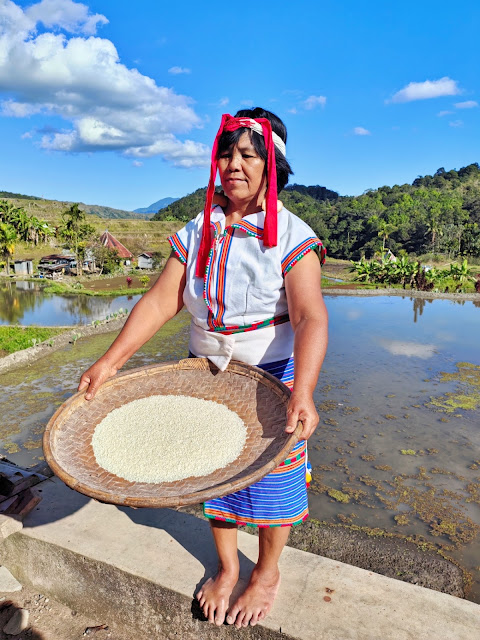 |
| One of the locals we met on our hike. She gladly wore a traditional garb as she demonstrates filtering rice |
On the fourth day,
we would embark on another rice terrace trek in a different town. This time, we
were escorted by Leandro Elahe, a local tour guide who could easily pass as a
historian. We began our walk in Bongan at the same location where a UNESCO marker
stands. Along the journey, we stopped at a few abodes to meet villagers who
demonstrated customary rice pounding and rice terrace farming practices.
Chasing Waterfalls
The first waterfalls
we visited only requires half an hour of hiking as the jump-off trail is
reachable by vehicles. Tenogtog Falls, as it’s called, takes its name from a
native word for "chopped" or "sliced." It is said that
during the olden days, following an arduous hunt, hunters would assemble near
these multi-tiered waterfalls to distribute the rewards of their kill.
 |
| Another series of cascades can be found below this many falls of Tenogtog. |
Despite the frigid
water, I surrendered to the urge of taking a dip on the crystal-clear stream as
a form of therapeutic relief for my body after the lengthy land travel to
Ifugao and the afternoon trek the day before. The following day, we visited
another waterfall, the A'pfaw Mahencha Falls.
 |
| Wouldn't let a good opportunity to take a dip pass by |
The hundreds of steps leading down to the waterfalls from the picturesque viewpoint now called Khohang Garden and back, can be taxing in a mountain environment where air becomes thinner.
 |
| Another day, another waterfalls. This time, its the A'pfaw Mahencha Falls |
Nevertheless, the sight of A’pfaw waterfalls will immediately
put you in a state of deep contemplation, where you can let yourself be
embraced by the breathtaking beauty of nature. While others in our group jumped
and splashed about in the chilly waters, I opted to relax and stare at the
waterfalls this time.
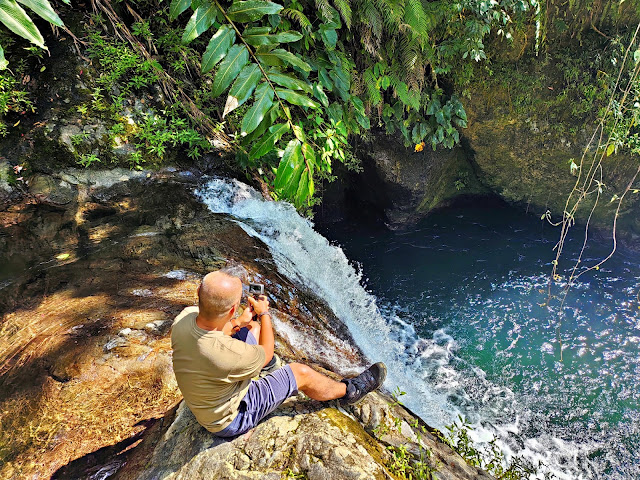 |
| Myself at the top of the first cascade of A'pfaw Mahencha Falls |
More #CultureTrip
Learnings
Outside of our rice
terraces and waterfalls exploration, we also went to a number of historical and
cultural sites around Mayoyao, accompanied not only by the local tourism staff
but also by the town's cultural bearer and historian, Bobby Bongayon, and in
one instance at the Mt. Nagchajan Historical Site, the town mayor himself,
Jimmy Padchanan Jr. They both delighted us with anecdotes about the rich
history and intriguing customs of Mayoyao.
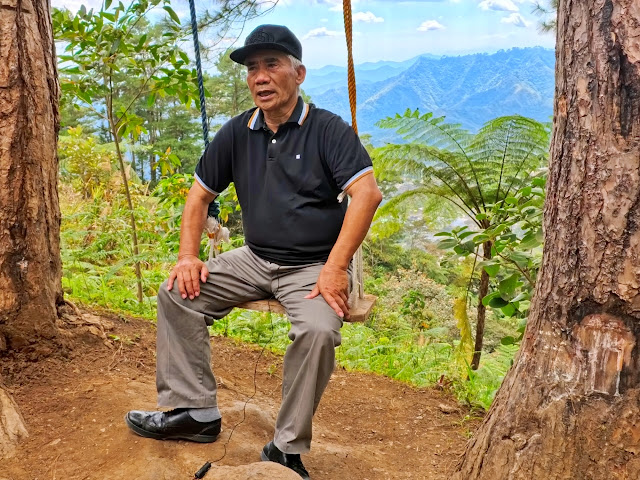 |
| Cultural bearer and historian, Bobby Bongayon regaled us with historical anecdotes as well as local legends and other stories about Mayoyao |
At Khohang Garden,
Bobby Bongayon led a storytelling session where he narrated a few legends handed
down from their ancestors as well as having us listen to a Hudhud chant
performed by a young lady, Jhomaica Panangon, a member of Mayoyao's Tourism
Office.
 |
| A young cultural bearer Jhomaica Panangon |
Stories chanted by
the Ifugao people as far back as the seventh century make up the Hudhud, an art
form recognized by UNESCO as part of the Intangible Cultural Heritage of
Humanity. There are hundreds of chants that cover topics such as history,
customary law, religious beliefs of the ancestors, and epic tales of warriors.
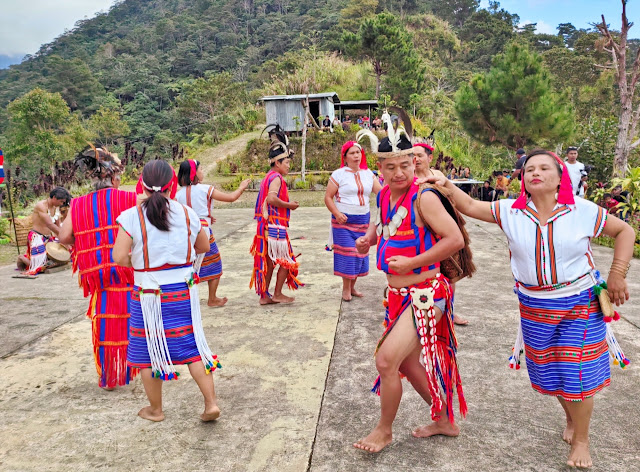 |
| Some of the locals demonstrated to us a number of their traditional dances |
Usually sang or
recited in the old days by an elderly person who holds a prominent role in the
community, either as a historian or preacher, to complete a comprehensive
recitation of the Hudhod may take several days.
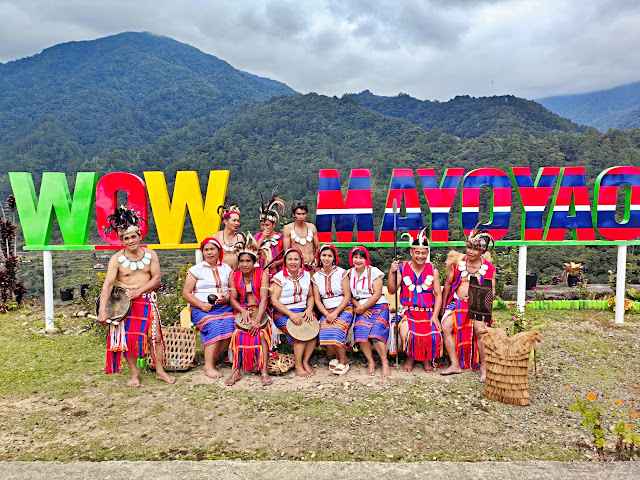 |
| Group shot after their cultural performance |
In Mt. Nagchajan,
we visited the place where the last band of Japanese soldiers made their last
stand during World War II. Amidst the breathtaking scenery, we were joined by
Mayor Padchanan Jr. as he further shared with us more about their local customs
and culture. Following a sumptuous lunch, the locals serenaded us with folk
songs and treated us to an amusing presentation of ceremonial and courtship
dances, in which some of us even took part in.
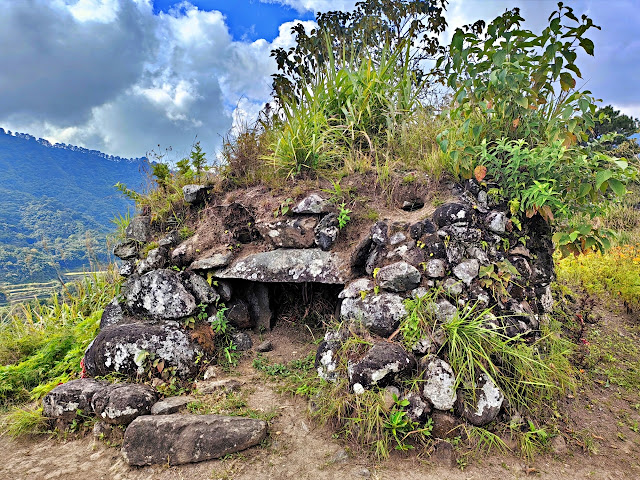 |
| You can still find a few ancient burial tombs called "Apfo-or" tombs in Mayoyao. These are the final resting place of an elite / warrior family in the old days |
In the process of
being both visually amazed and intellectually stimulated, our journey to
Mayoyao evolved into much more than a simple sightseeing tour. On any given
day, most of the people we met in Mayoyao would be going on with their daily
lives. But when visited by guest travelers, they easily open up to share their
proud history, culture, and traditions.
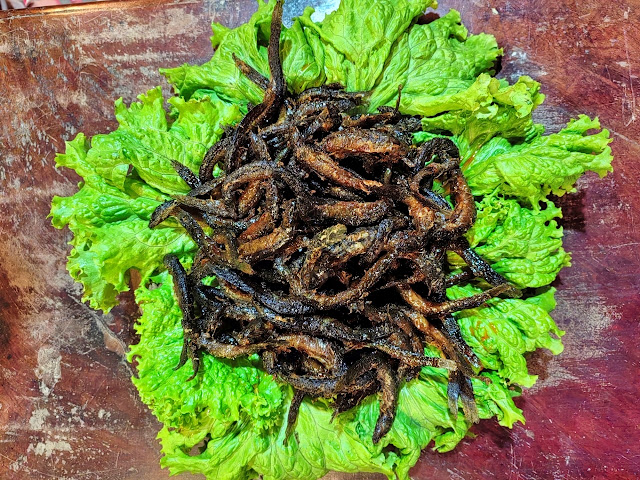 |
| Pikaw, is an elongated freshwater fish introduced by the Japanese in Mayoyao during WWII. Today, a pikaw hatchery plant is maintained in the town |
In a nation like
ours, where many ethnic treasures are sometimes overlooked in favor of
picture-perfect attractions, this is how I envision traveling. Instead of just
popping in and out, taking pictures, and then going away, an immersive
experience like what he experienced in Mayoyao should be replicated everywhere. By including locals in tourism activities, we provide
them with a voice and a platform to preserve and pass on their unique intangible
heritage.
 |
| Another cultural bearer let us listen to their traditional music |
Because of that,
our trip to Mayoyao, Ifugao became one for the books.






















